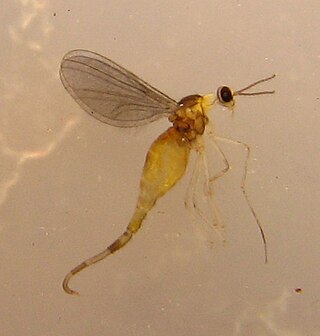
The Cecidomyiinae, commonly known as gall midges or gall gnats, is the largest subfamily in Cecidomyiidae with over 600 genera and more than 5000 described species. This subfamily is best known for its members that induce galls on plants, but there are also many species that are fungivores, parasitoids, or predators as maggots.
Catotricha is a genus of midges in the family Cecidomyiidae. The five described species in Catotricha are found in the holarctic region. This genus was established by British entomologist Frederick Wallace Edwards in 1938.
Monardia is a genus of wood midges, insects in the family Cecidomyiidae. The 53 described species in Monardia are grouped into three subgenera.
Micromyinae is a subfamily of wood midges, insects in the family Cecidomyiidae. Its members were formerly included in subfamily Lestremiinae. There are at least 55 genera and more than 650 described species in Micromyinae. All species in this subfamily are mycophageous.
Amedia is a genus of wood midges in the family Cecidomyiidae. The only described species - Amedia floridana - is only known from Florida. The genus was established by Mathias Jaschhof in 1997.
Haplusia is a genus of gall midges and wood midges in the family Cecidomyiidae. There are more than 20 described species in Haplusia.

Winnertziinae is a subfamily of gall midges and wood midges in the family Cecidomyiidae.
Wheeleriola is a genus of midges in the family Cecidomyiidae. The one described species in this genus - Wheeleriola perplexa - is known only from New Zealand.
Lestremiinae is a subfamily of Cecidomyiidae. It is composed of 105 described species classified into 13 genera. The larvae feed on fungi, primarily in rotting wood.
Allarete is a genus of midges in the family Cecidomyiidae. There are twelve described species in this genus. It is known from the holarctic, afrotropical, and oriental regions. The genus was first described by Arthur Earl Pritchard in 1951.
Anarete is a genus of midges in the family Cecidomyiidae. There are 38 described species. The genus was established by Irish entomologist Alexander Henry Haliday in 1833 and has a cosmopolitan distribution.
Mesotrichoca is a genus of midges in the family Cecidomyiidae. The one described species in the genus - Mesotrichoca mesozoica - is known only from Siberia from a sediment fossil associated with the Late Jurassic and Lower Cretaceous epochs. This species was placed in Catotricha when it was first described by Russian entomologist Vladimir Grigoryevich Kovalev. This genus was established by Mathias Jaschhof and Catrin Jaschhof in 2008.
Acoenonia is a genus of midges in the family Cecidomyiidae. The six described species are found in the holarctic region. The genus was first described by Arthur Earl Pritchard in 1947.
Bryomyia is a genus of midges in the family Cecidomyiidae. The six described species are found in the Holarctic and Oriental regions. The genus was first described by Jean-Jacques Kieffer in 1895.
Campylomyza is a genus of midges in the family Cecidomyiidae. The 40 described species are found in the Holarctic, Oriental, Neotropical, and Australasian regions. The genus was first described by German entomologist Johann Wilhelm Meigen in 1818.
Groveriella is a genus of wood midges, insects in the family Cecidomyiidae. The two described species are known only from Europe. The genus was established by Boris Mamaev in 1978.
Heterogenella is a genus of wood midges in the family Cecidomyiidae. The twelve described species are found in the Holarctic and Oriental realms. The genus was established by Boris Mamaev in 1963.
Neurolyga is a genus of wood midges, insects in the family Cecidomyiidae. The 28 described species occur in the holarctic region. The genus was established by Italian entomologist Camillo Rondani in 1840.
Polyardis is a genus of midges in the family Cecidomyiidae. The ten described species are found in the Holarctic and Australasian realms. The genus was first described by entomologist Arthur Earl Pritchard in 1947.
Tropaprionus is a genus of wood midges, insects in the family Cecidomyiidae. There are seven described species in Tropaprionus.

